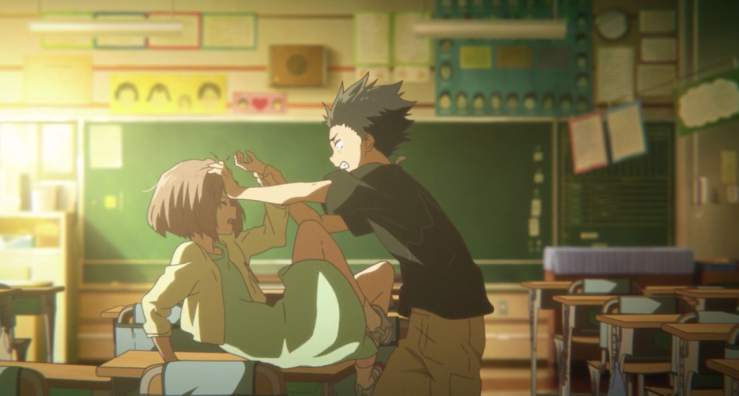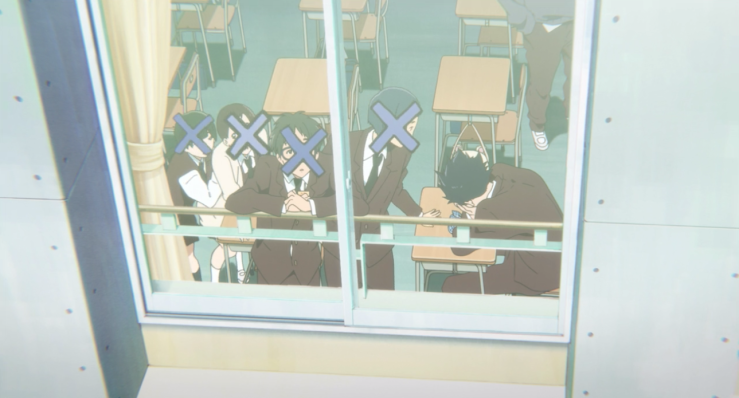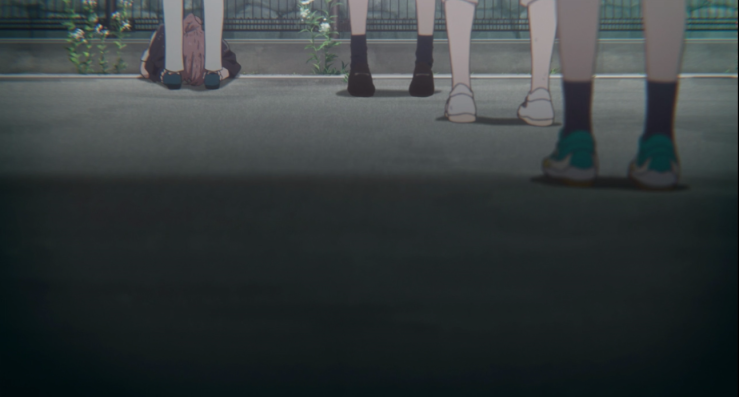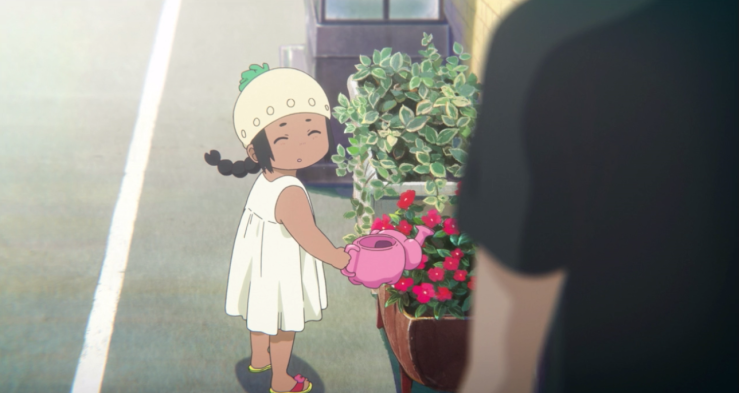I recently handed in the last essays of my University career. A momentous occasion, slightly undercut by the fact that the day I was finishing them I spent my entire morning watching, for the third time, A Silent Voice.
I have previously jotted down a few words about my relationship with that franchise, so I shall not reiterate it here. However, it isn’t just the formative role the manga played for me that makes the movie maybe my favourite of all time. The staff behind A Silent Voice have managed to make a complex and sensitive film, that can even tackle such dangerous themes like suicide well.
(Spoilers for the movie as well as discussion about suicide and it’s place in the movie follows. Please take care. Suicide hotlines worldwide are available here, as well as at the end of the essay.)
A Silent Voice tells the story of a bully. Our main protagonist Shouya is a traditionally unlikable character. He emotionally and physically bullies Shouko, a deaf girl, when she transfers into his class in middle-school. Eventually, his actions cause the school to get involved, and those who previously joined in and encouraged his cruelties turn on him. She leaves the school, and he takes her place as being severely bullied. After this arc, the first twenty minutes of the movie, we now follow Shouya as a highschool student, attempting to make amends for his past sins. Contrary to, the quite odd localised title1, A Silent Voice is not solely about Shouko nor her deafness. Rather the realities of her, and Shouya’s, lives as a whole take centre stage.

Suicide, is a constant presence in A Silent Voice. Before we have the opening backstory, the movie depicts high-school Shouya preparing for to kill himself. But even past that, the central motifs of the film do not let us forget it. Shouya and Shouko constantly missing each other’s hands as they fall off things. Repeated instances of jumping into rivers. Even Shouya’s empty room itself.
Shouya’s depression, self-loathing, and guilt are several aspects which we can take as being ‘why’ he makes such a decision, even if his attempt is ultimately non-fatal. But, importantly, we are not given explicit end-all-be-all account. Nor are Shouya’s actions attributed to some other agent’s influence. We know he is, and has been, isolated and lonely for years. However we also know such isolation was partly self imposed. Middle-school Shouya may have been severely bullied, but from what we see of his high-school life his isolation is self imposed.

Shouko is also depicted as struggling with suicidal ideation. The climax of the movie involves her own attempt, which is also non-fatal. Her state and struggle differ substantially from Shouya’s, though her guilt and self-loathing are somewhat similar. For both Shouya and Shouko, no single event causes or sparks their attempts. This is important. Suicide is an individual’s decision, and is never caused by simple or singular means2.
Shouko and Shouya’s actions in this regard are not without consequence. Their families responses are also given focus.
In Shouya’s case his mother’s emotional response is extreme. The tears in her eyes and deformation of her expressions places an emphasis on her concern and distress. Her tension is shown as her grip on the spatula tightens, as she does her best to ensure that Shouya never attempts such a thing again. A Silent Voice does it’s best to show the effects suicide has on a family without demonising such actions. Shouya’s mother cares about him and her worries and concerns are solely about him, not about people’s perceptions of their family as they could have been. His mother is most always shown to be caring. She sacrifices and struggles for those around her, and is never shown to have negative opinions of even those who lash out her. Rather, her sympathies are endless.
Which makes her response to Shouko, and Shouko’s family, after her attempt all the more amazing. Shouya, in stopping her, was physically injured in a major way. Thus, Shouko’s sister, Yuzuru, and her mother essentially beg for forgiveness from Shouya’s mother. Shouya’s mother, despite being sympathetic. Despite caring greatly for everyone. And despite having been bloodied by Shouko’s mother years ago, does not accept their apologies. When they kneel at her feet, she kneels with them and asks them to raise their heads. Not through any callousness or distress of her own, but simply because it isn’t their apology to give. When Shouko, with a broken arm from her attempt, prostrates herself in tears and apologises, Shouya’s mother does not reject her. She remains standing and lets Shouko cry and apologise fully.

Whilst I am not going into detail on it here, A Silent Voice does give Shouko’s family and their responses to her suicide attempts focus. A central part of the makeup of their apartment, and of their family life is eventually revealed to be the case because of her suicidal ideation. Again, she is not demonised for that, even if she is called “Stupid” for doing so. One of the greatest strengths of A Silent Voice as a movie is how much sympathy it has for it’s cast. There is little in the way of blame, even for actions it accepts are wrong.
Depicting suicide and the complex effects it has on those around it in these fashions is a good thing. Most guidelines emphasise the importance of neither sensationalising nor normalising suicide. Stigmatising suicide can cause people suffering from ideation to not get the help they need. It also places unfair burdens on those who have been affected by suicide, either from their own attempts or from those who attempted or completed it around them. Normalisation of suicide can also contribute to the desensitisation of the issue. Suicide ought to be as ‘heavy’ as it is. It isn’t something we want from people, and certainly isn’t something we want people to take lightly.
A Silent Voice also offers the gift of being a movie with so much focus on two suicidal teens that also does not kill either of them. Their suicide attempts achieve nothing, they solve nothing. Yet, their potential for happiness and potential to live on is granted to them. I feel these are good things to emphasise in a movie about teenagers struggling in such a way3. And, on a more personal level, I really appreciate a depiction of suicide that neither guilt trips me for my own relation with it, nor normalises it. A Silent Voice also deliberately keeps its world beautiful. Managing to keep its cast’s problems framed as genuine whilst they inhabit a beautiful world may have been tough, but such beauty inspires hope. Genuine hope in media covering suicide is a blessing.
(Suicide hotlines for many countries are available here .)

Notes:
- The literal title the film uses is ‘The Shape of Voice’. While you may find this to be a really minor thing to spend any time discussing there are some large differences between the two. ‘a’ is a much weaker singular term. ‘a hat’, for instance, is not picking out any particular hat. Though in this instance ‘A Silent Voice’ can only be referring to Shouko’s, since she primarily talks through sign-language. Further the ‘silent’ aspect of the localisation emphasises said sign-language above all other communication. But that is not how the movie, or indeed the manga, treats Shouko. The ambiguity and specificity of ‘The Shape of Voice’ functions far better. ‘The’ pulls out the particular, and is much stronger than ‘A’. However, within the context of the movie the specific ‘shape’ that is being referred to does not make sense as any individuals, but rather about the concept of voice, or perhaps communication as a whole. A Silent Voice is a movie about how we as people attempt to communicate. I do feel emphasising that aspect works far better. (Credit to Jao for his tweets that inspired these kinds of thoughts)
- See The WHO’s media guidelines.
- I am not a psychologist. There may very well be reasons for people to criticise A Silent Voice as harmful. I do not believe that to be the case, but if someone more qualified to say so says then I shall edit this to include them.
[…] How ‘A Silent Voice’ succeeds at a difficult topic […]
LikeLike
I have actually called that hotline thingy in my country once. A girl on the other end called me pathetic, named a few examples of people “having it much tougher but actually doing something to change it” and wished me to pull myself together, good times.
I am not a psychologist either, but I appreciate the hell out of ASV’s attempt at suicide depiction, too.
Thanks for the post.
LikeLike
I’m so so sorry. That really sucks. I’m glad that you liked my post.
LikeLike
[…] How ‘A Silent Voice’ succeeds at a difficult topic […]
LikeLike
[…] How ‘A Silent Voice’ succeeds at a difficult topic […]
LikeLike